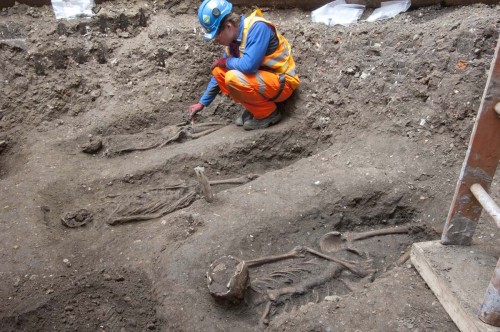In order to build the new Elizabeth line station at Liverpool Street, some 3,000 skeletons from the Bedlam burial ground have to be removed, and the removal process has just started.
The excavation will allow the construction of the eastern entrance of the new Liverpool Street station. A team of 60 archaeologists will work in shifts, six days a week to remove skeletons and record evidence for what may prove to be, in archaeology terms, London’s most valuable 16th and 17th-century cemetery site.
The Bedlam burial ground was in use from 1569 to at least 1738, spanning the start of the British Empire, civil wars, the Restoration, Shakespeare’s plays, the Great Fire of London and numerous plague outbreaks. 2015 marks the 350th anniversary of London’s last Great Plague in 1665 and archaeologists hope that tests on excavated plague victims will help understand the evolution of the plague bacteria strain.
Nick Elsden, Project Manager from MOLA said: “Construction for Crossrail is providing rare and exciting opportunities for archaeologists to excavate and study areas of London that would ordinarily be inaccessible, such as under established road systems. There are up to six metres of archaeology on site, in what is one of the oldest areas of the city, so we stand to learn a great deal.”
The research also aims to shed light on migration patterns, diet, lifestyle and demography of those living in London at the time. Excavated skeletons will be taken to MOLA for testing by osteologists (bone specialists) before being reburied in a consecrated burial ground.
The skeletons will be excavated over the next four weeks, after which archaeologists will dig through medieval marsh deposits and Roman remains. A Roman road runs under the site, which has already yielded several interesting Roman artefacts such as horseshoes and cremation urns. Archaeologists are expected to finish on site in September.
Bedlam is London’s first municipal burial ground and was located just outside the original City Wall. It was used by people from around London who could not afford a church burial, or who chose to be buried there for religious or political reasons. It was also used as an ‘overflow’ cemetery when existing sites were full, including in times of plague.
Many people buried at Bedlam were on the fringes of society. Common occupations included servants, maids, tailors, shoemakers and watermen, although middle-class guilds such as butchers and goldsmiths were also buried there. Many different ethnicities are represented, reflecting a globalising city. The plague was the most common listed form of death, followed by infant mortality and consumption.
Famous 17th-century political ‘Levellers’ such as John Lilburne and Robert Lockyer are believed to be buried there.








